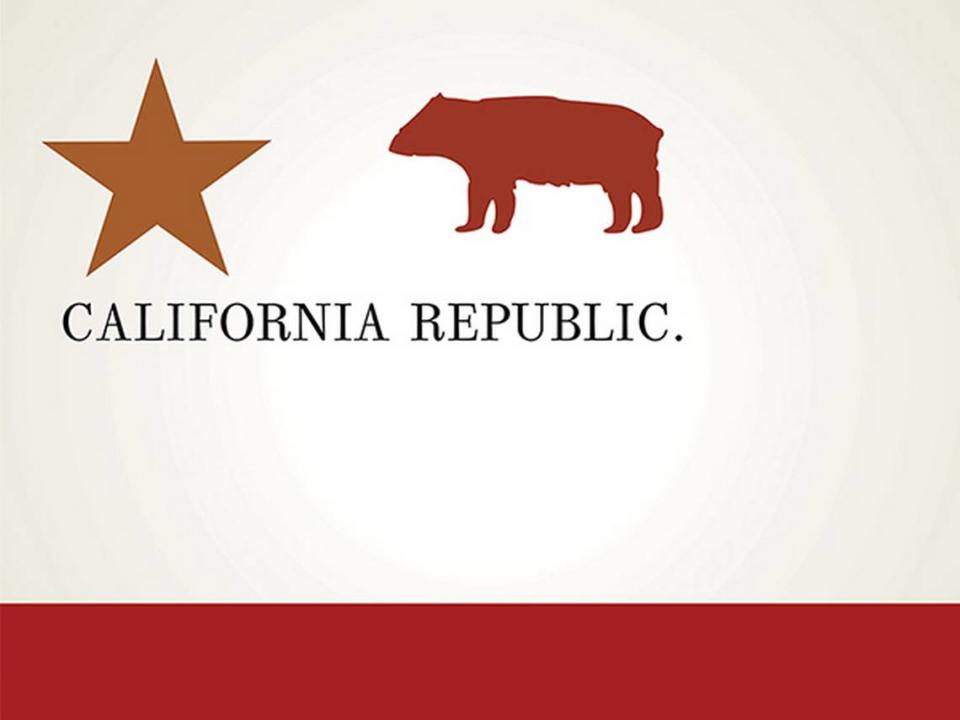Liberal California has a state flag tied to the Confederacy. How can that be? | Opinion
Here’s a history lesson you’re unlikely to find in textbooks: California’s bear flag has links to white supremacy and pro-slavery.
Here’s another: California entered the union as a “free” state, yet enslavement was widely condoned. As many as 1,500 enslaved African Americans lived in California in 1852.
That completely contradicts what most of us learned in school.
We grew up believing the enslavement of Black people happened in other places — Georgia, Virginia, Mississippi.
Anywhere but here.
“Slavery was an evil that occurred in the South, far from here, or so we were taught,” writes the California Historical Society. “Yet famed for its liberal reputation, California has a far more complicated history.”
That “complicated history” has been largely hidden from view, like the story of the bear flag.
The Washington Post recently included it on a list of seven state flags “that still have designs with ties to the Confederacy.” The California flag, the article says, is the “least obvious” of the seven.
Flag supported ‘secession and slavery’
Here are the most salient facts about the bear flag: A crude version was designed in 1846 by a small group of possibly drunken and definitely racist renegades who led the short-lived Bear Flag Revolt in an effort to break away from Mexico. (“They despised the native, Spanish-speaking Californios, whom they called greasers,” an op-ed in the Los Angeles Times reports.)

A few weeks later, a naval squadron raised the Stars and Stripes and claimed California for the U.S. and the bear flag was lowered.
The design was resurrected later when the Civil War broke out. According to the Washington Post, “a number of communities flew the disused bear flag to express their support for secession and slavery.”
The flag was adopted as the state’s official flag in 1911, after the Native Sons of the Golden West lobbied the Legislature to adopt their marching banner as the state flag.
Founded in 1875, the all-white, fraternal organization was unabashedly racist. Here’s a statement a former president of the organization wrote in April 1920: “California was given by God to a white people, and with God’s strength we want to keep it as He gave it to us.”
The group’s primary mission was to preserve and document California’s historic buildings, but its history of racism and its anti-immigrant policies have led to backlash.
Last year, a high school district Board of Trustees in Sonoma voted to remove three plaques that the Native Sons had installed on school campuses.
“These plaques, seeing them and knowing their history, it feels oppressive seeing them every morning as I enter the main building,” student KatieAnn Nguyen said, according to report by The Press Democrat. “If the group that donated these very plaques were openly racist towards Asian Americans, then as an Asian American, how can I begin to feel welcome at this school?”
We don’t know what we don’t know
Why dwell on the history of the bear flag? Because it goes to show that when it comes to our past, we don’t know what we don’t know
Hopefully, that’s changing as California revamps its curriculum to include ethnic studies.
But for generations, we were fed a sanitized version of history that, among other faults, turned people like the Bear Flaggers into freedom fighters and glossed over decades of racial segregation and discrimination, including the fact that California sometimes held more KKK events per year than Mississippi or Louisiana, according to the California Reparations Report.
Generations of discriminatory practices in housing, lending, employment, education, health care and law enforcement made it almost impossible for Black families to build and pass down wealth from generation to generation.
In 2019, white households owned nine times as many assets as Black households, the reparations report says.
What do we do with the information?
Sure, we can remove plaques, rename buildings, even expunge racial covenants that ban Black people from white neighborhoods.
Maybe we could redesign the state flag, if that would make things right.
It would not.
Those steps, while important, are not going to help a Black family buy a home, or get adequate health care or send a child to college.
Here’s one thing we can do: Keep an open mind when it comes to reparations.
Cash reparations widely opposed
That’s not going to be as easy as it sounds.
According to a Los Angeles Times/UC Berkeley survey, 59% of California voters already oppose any form of cash payment and only 28% support it.
The No. 1 reason for opposition: “It’s unfair to ask today’s taxpayers to pay for wrongs committed in the past.”
Yet how much do we really know about the wrongs committed in the past — and how they may be affecting us to this day?
Before we decide whether reparations are necessary and, if so, what form they should take, shouldn’t we all be on the same page?
The California Reparations Report is a good starting place. At over 1,000 pages, it’s a lot to digest, but please, don’t let your eyes glaze over quite yet. The executive summary is a way to ease into it.
The story behind California’s grizzly bear flag is an example of how history has been framed: We’ve only gotten bits and pieces, rather than the entire picture — sort of like the tale of the blind men who were trying to describe an elephant. One felt a tusk, another an ear, yet another a foot, and so on. The description was nothing at all like an elephant.
We must look at the entire picture to get a sense of how we got to where we are today. Only then can we figure out, as Californians, where we go from here.

